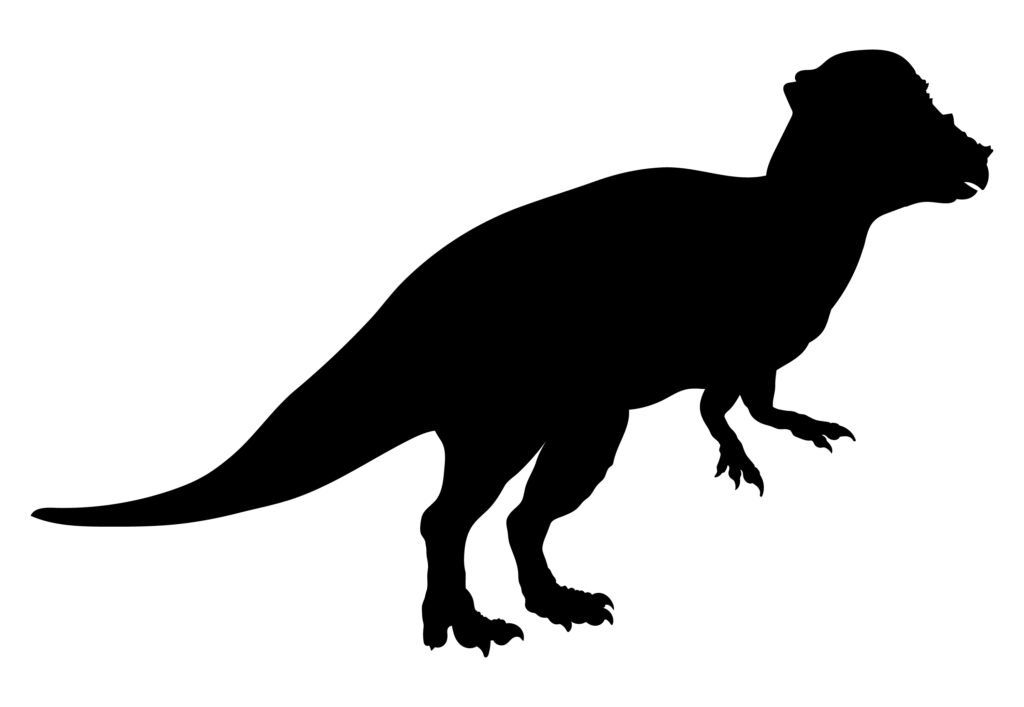Pachycephalosaurus
Pronunciation:
Pack-ee-sef-uh-lo-sore-us
Name Meaning:
“Thick-headed lizard”
Dinosaur Classification:
- Kingdom: Animalia
- Phylum: Chordata
- Class: Reptilia
- Order: Ornithischia
- Suborder: Marginocephalia
- Family: Pachycephalosauridae
- Genus: Pachycephalosaurus
- Species: P. wyomingensis
Dinosaur Description:
Pachycephalosaurus, one of the most famous members of the Pachycephalosauridae family, is best known for its distinctive thick skull. The dome-shaped skull, which could be up to 10 inches (25 cm) thick, has sparked numerous theories about its use, with some researchers suggesting that it was used in head-butting contests, much like modern-day rams. This dinosaur lived during the Late Cretaceous period, approximately 70 to 66 million years ago, and its fossils have been found primarily in North America.
Pachycephalosaurus was a bipedal herbivore, meaning it walked on two legs and fed on plants. Its body was relatively small and light compared to other herbivorous dinosaurs, with estimates suggesting it grew to around 15 feet (4.5 meters) in length. This dinosaur likely lived in herds or small groups, using its thick skull for defense or possibly for intra-species competition over territory or mates. However, the idea of head-butting is still debated, as some scientists believe that the skull may not have been built to withstand direct impact but rather for display purposes or protection against predators.
The structure of Pachycephalosaurus’ teeth indicates that it fed on soft plants, fruits, and possibly seeds. Unlike large herbivores with complex chewing mechanisms, Pachycephalosaurus likely cropped low-growing vegetation and swallowed it whole. Its relatively small body and lightweight frame suggest it may have been quite agile for a dinosaur, helping it escape predators or navigate dense forested environments.
The thick skull of Pachycephalosaurus is one of the most puzzling features in paleontology. Some fossils show evidence of wear or trauma, which could support the head-butting theory. However, this trauma might also have been the result of defending itself from predators. Its flat, leaf-shaped teeth and small, pointed beak further suggest a diet specialized for softer plants.
Dinosaur Diet and Behavior:
Pachycephalosaurus was an herbivore, feeding on soft plants, fruits, and seeds. Its small, sharp teeth were well-suited for slicing vegetation, but it likely swallowed food without much chewing. It may have used its thick skull for display, defense, or even for head-to-head combat with other members of its species.
Dinosaur Size:
Pachycephalosaurus was approximately 15 feet (4.5 meters) in length from head to tail.
Dinosaur Weight:
It is estimated that Pachycephalosaurus weighed around 990 pounds (450 kg).
Fossil Discoveries:
The first Pachycephalosaurus fossils were discovered in the Hell Creek Formation of Montana, USA, in the early 20th century. Since then, additional specimens have been found in South Dakota and Wyoming. The thick skull cap is the most commonly found fossilized part of Pachycephalosaurus, and for many years, it was the only part known. More complete skeletons were uncovered later, providing a better understanding of its overall appearance.
What Period Did The Dinosaur Live:
Pachycephalosaurus lived during the Late Cretaceous period, about 70 to 66 million years ago.
Notable Facts or Trivia:
– Pachycephalosaurus is famous for its dome-shaped skull, which may have been used for head-butting.
– Its name means “thick-headed lizard,” referring to its unique cranial structure.
– Pachycephalosaurus may have lived in small herds and used its skull for defense or intra-species competition.
– Most Pachycephalosaurus fossils consist of its distinctive thick skull, which has led to speculation about its behavior.
Scientific Significance:
Pachycephalosaurus has provided significant insights into the diversity of dinosaur species during the Late Cretaceous period. Its thick skull has prompted discussions on dinosaur behavior, social interaction, and defense mechanisms. The debates surrounding its potential use of head-butting have made Pachycephalosaurus one of the most studied and intriguing dinosaurs in paleontological research. Its fossils have also shed light on the ecosystems and environments of North America during the Cretaceous.
Extinction & Legacy:
Pachycephalosaurus went extinct at the end of the Cretaceous period during the mass extinction event 66 million years ago, which wiped out nearly all dinosaur species. However, its unique skull and potential for head-butting behavior have left a lasting legacy in popular culture and scientific inquiry. Today, Pachycephalosaurus remains one of the most iconic dinosaurs, frequently featured in documentaries, films, and exhibits due to its distinctive appearance and the mystery surrounding its behavior.

